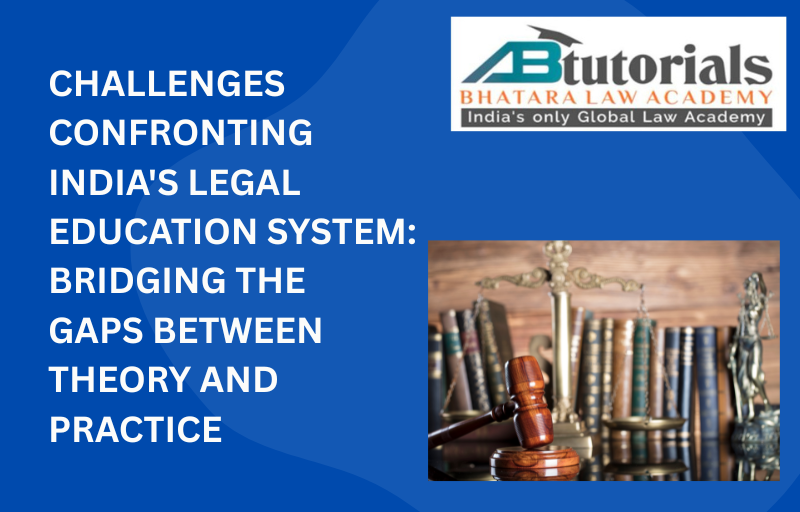CHALLENGES CONFRONTING INDIA'S LEGAL EDUCATION SYSTEM: BRIDGING THE GAPS BETWEEN THEORY AND PRACTICE
By ABT Team
09 Sep, 2025

India's legal education is plagued by numerous challenges that hinder it from providing the skills necessary for students to excel in the legal profession. Despite significant strides taken in the recent past, the gap between theoretical objectives and practical solutions is a major area of concern. In this article, the significant challenges are outlined, and recommendations are provided to bridge the gap, equipping Indian law graduates for the realities of the modern legal landscape.
Challenges in Legal Education
1. Obsolete Curriculum
The Indian law syllabus falls behind the changing legal landscape. Law schools still study old subjects and course materials, and graduates are not equipped to deal with the changing nature of the legal profession. Focus on memorization and repetition of legal provisions, and not on problem-solving and critical thinking skills, is a factor in the problem.2. Inadequate Infrastructure
The majority of law schools in India are faced with infrastructural challenges, including overcrowded classrooms, poorly equipped libraries, and inadequate facilities for sophisticated technology. These challenges compromise the learning process and restrict the availability of necessary resources to students.3. Limited Practical Training
Indian legal education has long been based on theoretical learning, with minimal opportunity for practice of skills. This may make graduates ill-prepared for the actual practice of law and may lead to them having little confidence in their skills.4. Lack of Trained Teachers
Law schools are faced with difficulty in recruiting qualified law professionals as educators in these institutions. The necessity for NET-trained teachers has limited the number of possible professors, and screening panels usually do not have the flexibility to evaluate the quality of teachers.5. Access and Affordability
Indian legal education is generally costly and out of reach for lower socioeconomic group students, restricting diversity in the legal profession.Closing the Gap between Theory and Practice
To overcome these challenges, some strategies can be adopted:1. Curriculum Reform
- Incorporate Current Issues: Reform the curriculum to include current legal issues and emerging trends, such as environment law, cyber law, and international human rights.
- Highlight Critical Thinking: Foster critical thinking and problem-solving abilities by means of interactive pedagogical practices such as moot courts, debates, and case studies.
2. Improve Infrastructure
- Invest in Technology: Incorporate cutting-edge technology to improve learning experiences, such as virtual classrooms and digital libraries.
- Enhance Infrastructure: Make sure the class rooms and libraries are well equipped and learning-friendly.
3. Encourage Practical Training
- Clinical Programs and Internships: Create clinical programs and internships to engage students in legal practice hands-on.
- Legal Clinics and Moot Courts: Encourage students to attend moot courts and legal clinics in order to learn practical skills.
4. Employ and Retain Top-Notch Faculty
- Adaptable Recruitment Criteria: Consider easing the NET qualification requirement to encourage more mature legal academics to join the academic profession.
- Professional Development Opportunities: Provide regular training and professional development opportunities for faculty members to become better teachers.
5. Enhance accessibility –
- Scholarships and Financial Assistance: Offer scholarships and financial assistance to make legal studies more accessible to students from various backgrounds.
- Online Platforms: Leverage online platforms to access a larger number of users and provide flexible learning.
Conclusion The issues of Indian legal education are intricate and demand a holistic approach of reform. With the process of modernizing curricula, enhancing infrastructure, promoting practical training, attracting quality faculty, and reducing the costs of education, India can overcome the divide between theoretical education and practice. The shift will not just improve the quality of legal education but will also empower future lawyers with the expertise needed to survive in an increasingly complex legal environment.
Recent Articles
-
09 Sep, 2025
CHALLENGES CONFRONTING INDIA'S LEGAL EDUCATION SYSTEM: BRIDGING THE GAPS BETWEEN THEORY AND PRACTICE
By ABT Team
-
12 Aug, 2025
How to Become a Lawyer in the UK as an International Student – A Guide for Foreign Students
By ABT Team
-
05 Aug, 2025
Comparative Analysis of Legal Education Systems: India vs. Global—Learning from International Practices
By ABT Team
-
29 Jul, 2025
The Role of Legal Academia in India: Careers in Teaching, Research, and Policy-Making
By ABT Team
-
22 Jul, 2025
The Role of International Organizations in Career Building for Indian Lawyers: Opportunities in UN, WTO, and Other Global Institutions
By ABT team
-
15 Jul, 2025
Legal Aspects of Immigration and Career Opportunities: Pathways in Visa, Refugee, and Immigration Law
By ABT Team
-
08 Jul, 2025
Building an International Law Career from India: Opportunities in Cross- Border Trade, Diplomacy, and Human Rights
By ABT TEAM
-
01 Jul, 2025
Introduction: New Frontiers of Legal Practice and Digital Contracts Using Blockchain Technology
By ABT Team
-
24 Jun, 2025
Careers in Intellectual Property Rights Law: Protecting Innovations
By ABT TEAM
-
17 Jun, 2025
Artificial Intelligence in Law: Revolutionising Legal Practice
By ABT Team

